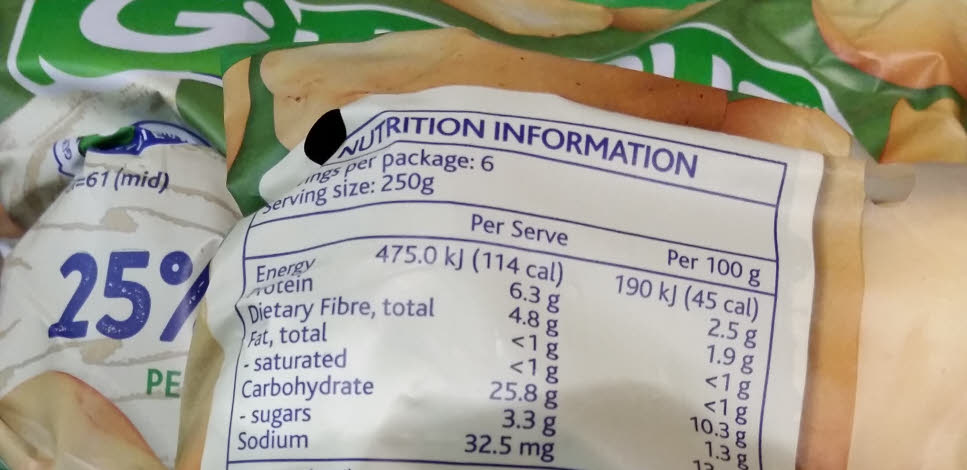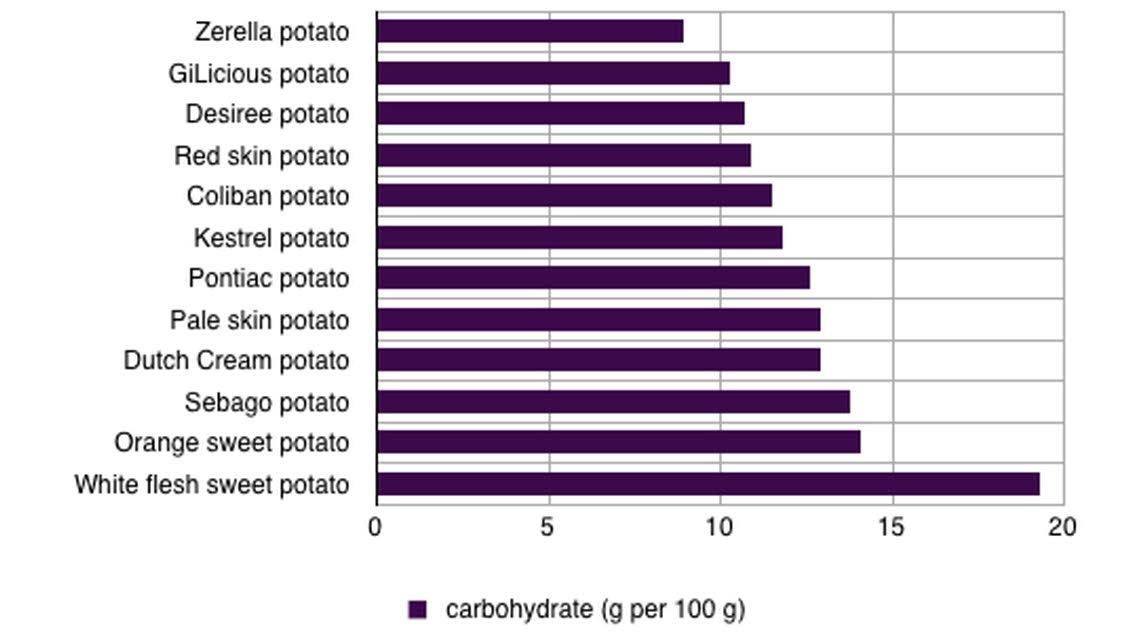which potato is best to eat?
How much is a serve?
Is it better to skip potatoes and eat a different vegetable instead?

Last week, out of curiosity, I bought a bag of baby lite spuds labelled "25% less carbs".
When raw, they suction-gripped the knife blade as it sliced through the flesh. At the table, no one commented on the lite spuds’ texture or flavour but none of us claim to have a potato connoisseur’s taste buds. They tasted great like other fresh potatoes.
Nutrition-wise, were they worth it?
This prompted me to dish up a few interesting nutritional facts about potatoes and share my thoughts on the energy and carbohydrate content of popular potato varieties.
Potato facts:
- A single serve of un-peeled boiled potato or sweet potato provides 100% of your daily vitamin C needs. Boiling causes big nutrient losses by leaching of nutrients from the food into the water. I chose boiling to show that even with this nutrient-depleting cooking method, you still get great nutritional value from potatoes.
- All potatoes are a valuable source of vitamin C, folate, fibre, potassium and selenium.
- A single serve of cooked sweet potato provides 265% of your daily vitamin A needs.
- A single serve of potato, sweet potato, swede or parsnip provides more fibre than a slice of wholegrain bread.
- Potatoes help hydrate your body. Potatoes naturally contain a lot of water. Close to 80% of a raw potato is water.
- Potatoes are a naturally very low fat food. Less than 1% of a raw potato is fat. That’s less than 1 g fat in every 100 g of spud.
- Potatoes are a naturally low sodium salt food.
- Potatoes deliver many more health benefits to you than white rice, noodles and pasta.
- The green colour in potato skin is due to solanine and it is toxic to humans. Thrown green spuds away. Store potatoes in a dry dark place to keep them fresher longer and delay greening.
- Carbohydrate (carb) is the main energy source supplied by potato. The carb content varies depending on the potato variety. The lowest is Zerella with 8.9 g per 100 g. GiLICIOUS comes in at 10.3 g per 100. Both of these are marketed as low carb potatoes and claim ‘25% less carbs’. The highest carb content is found in white flesh sweet potato with 19.3 g per 100 g. See the chart below.
- The lower the carb content, the lower the total calorie (kilojoule) content.
But when served up, does the difference in carbohydrate content really make that much of a difference?
The answer depends on how much you usually eat and your weight, shape and health goals.
The difference in carb content and energy across different white potatoes is small (excludes white sweet potato). A difference of a mouthful or two per serve will align the carbohydrate and energy content of potatoes (excludes all sweet potatoes).
If you want to lose weight, check your serve size and think about whether your cooking method or what you serve with them is the best for your body.
If you have diabetes and need to adjust insulin doses, you may prefer or need to weigh your fresh spuds to know much carbohydrate is present. Absolute precision is not necessary though because there is some variation in carbohydrate content and glycemic index across the seasons. The serve size for white flesh sweet potatoes is much smaller than all other potatoes for people with diabetes.
If your diabetes is managed by diet alone or with tablets, you will want to manage your carbohydrate intake from meal to meal, day to day. You may have been told to reduce your total carb intake as well.
Apply these tips to reduce your carbohydrate intake from potatoes:
- Replace part of your usual potato serve with more cooked ‘light’ vegetables. You get to eat more food and consume an even bigger variety of vitamins and minerals, yet slash your intake of kilojoules and carbohydrate. A win, win for keeping your weight and health in check.
- Add a swede to the saucepan and reduce how many spuds go in to slash the carbs and kilojoules further. Swedes contain more vitamin C and folate but less carbohydrate than regular potatoes.
- Cook a little less and serve a little less to reduce the carb and calorie intake from potatoes.
- Cut your intake of white flesh sweet potatoes even further. If you usually eat ½ cup of potatoes, you’d only eat ⅓ cup of white sweet potatoes to keep your carbohydrate and energy intake close to your usual serve of potato.
- Buy potatoes labelled "25% less carbs" when they are available. They seem to be a seasonal product.
Apply these tips to get the most from your potato serve:
- Save time on meal prep and clean-up.
- Wash or scrub but don’t peel your potatoes. Not only time-saving but the bonus is you eat more fibre which helps satisfy and keep hunger at bay longer.
- Cut washed potatoes into chunks and steam or boil on the stove top.
- Microwave small washed potatoes with the skin on. Prick the skin several times with a fork before placing on kitchen paper in the microwave to cook.
- Place small washed potatoes in the skin straight on to the oven rack to bake.
- Precook wedges of potato, skin still on. Drain away water. Spray with or toss in oil and crushed garlic. Lightly sprinkle with cumin for extra flavour. Sprinkle turmeric for a richer golden colour. Bake in a hot oven or covered BBQ until golden brown. A far more healthy and delicious choice than oven-baked commercial wedges.
- Toss small unpeeled, washed potatoes in oil. Add spice, garlic or herbs to the oil before tossing if you wish. Place spuds inside a thick brown paper bag (if the bags are thin, place one bag inside another to add strength). Scrunch down the open end to seal the bag well. Lay the filled bag on its side on an oven rack and bake at 200C for about 35 minutes or until cooked.
- Flavour your spuds differently.
- Top potatoes with plain yoghurt or yoghurt dip (e.g. tzatziki) instead of sour cream.
- Top spuds with cottage cheese and spicy salsa.
- Mash potatoes, skins and all, with milk and cracked pepper.
- Mash potatoes with chutney or pickles instead of butter and margarine.
- Give fried and reconstructed potato the flick.
- Empty the home freezer of frozen pre-fried potato wedges, hash browns, potato nuggets, chips, fries and potato recreations.
- Reduce how much and how often you eat of these foods when out.
What do I do?
For general use, I am not too fussy about which potatoes I buy. I like all varieties but my favourite everyday potatoes are the versatile ones. If I am buying a kilo of spuds, I want to know I can steam, bake, mash or roast them to suit the meals I am making. The nutritional quality is excellent no matter which potatoes I choose.
I will add swedes to the pot because they taste good. Sweet potatoes replace part of the traditional potato serve and don’t dominate the plate.
If I’m served chips with a meal, I leave some uneaten behind on the plate.
I pay more attention to avoid green potatoes than worry about their carbohydrate content.
carbohydrate content of potatoes
How do different potato varieties compare?
These nutrient values are a snapshot in time. The nutrient profiles change a little with the season and may differ slightly between growing regions.

NOTE: I am an independent dietitian and nutritionist. This article is written impartially and with honesty.
It is not tainted by industry influences.
